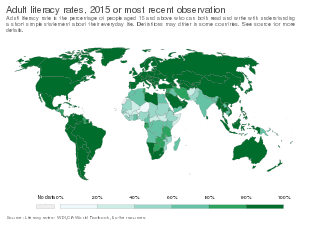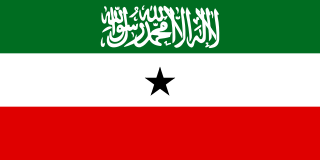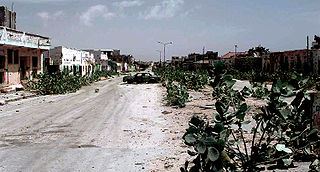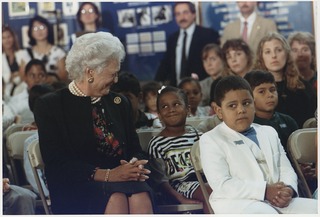
Literacy is the ability to read and write. Some researchers suggest that the study of "literacy" as a concept can be divided into two periods: the period before 1950, when literacy was understood solely as alphabetical literacy ; and the period after 1950, when literacy slowly began to be considered as a wider concept and process, including the social and cultural aspects of reading and writing and functional literacy.

Somalia, officially the Federal Republic of Somalia, is the easternmost country in continental Africa. The country is located in the Horn of Africa and is bordered by Ethiopia to the west, Djibouti to the northwest, Kenya to the southwest, the Gulf of Aden to the north, and the Indian Ocean to the east. Somalia has the longest coastline on Africa's mainland. Somalia has an estimated population of 18.1 million, of which 2.7 million live in the capital and largest city, Mogadishu. Around 85% of its residents are ethnic Somalis and the official languages of the country are Somali and Arabic, though the former is the primary language. Somalia has historic and religious ties to the Arab world. As such the people in Somalia are Muslims, the majority of them Sunni.

Communications in Somalia encompasses the communications services and capacity of Somalia. Telecommunications, internet, radio, print, television and postal services in the nation are largely concentrated in the private sector. Several of the telecom firms have begun expanding their activities abroad. The federal government operates two official radio and television networks, which exist alongside a number of private and foreign stations. Print media in the country is also progressively giving way to news radio stations and online portals, as internet connectivity and access increases. In 2012, a National Communications Act was also approved by Cabinet members, and 2 October 2017, the president of Somalia Finally signed the National Communications Law, and became the official Law that regulated the ICT industry. Under that Law, National Communications Authority (NCA) of the federal Republic of Somalia has been established, with board of directors and a general manager. Somalia currently is ranked first in Africa for most affordable mobile data per gigabyte and 7th in the world.

Somaliland, officially the Republic of Somaliland, is an unrecognised country in the Horn of Africa. It is located in the southern coast of the Gulf of Aden and bordered by Djibouti to the northwest, Ethiopia to the south and west, and Somalia to the east. Its claimed territory has an area of 176,120 square kilometres (68,000 sq mi), with approximately 6.2 million people as of 2024. The capital and largest city is Hargeisa.

Puntland, officially the Puntland State of Somalia, is an autonomous territory formed in 1998 that became a federal member state. Puntland is located in the northeastern part of Somalia and its state capital is the city of Garoowe in the Nugal region. The region had a population of 4,334,633 in 2016.

Bosaso, historically known as Bender Cassim is a city in the northeastern Bari province (gobol) of Somalia. It is the seat of the Bosaso District. Located on the southern coast of the Gulf of Aden, the municipality serves as the region's commercial capital and is a major seaport within the autonomous Puntland state.

Between the fall of Siad Barre's government in January 1991 and the establishment of the Transitional National Government in 2006, there was no central government in Somalia. Large areas of the country such as Puntland and Galmudug were internationally unrecognized and administered as autonomous regions of Somalia, while forces in the northwest declared the Republic of Somaliland. The remaining areas, including the capital Mogadishu, were divided into smaller territories ruled by competing faction leaders. During this period, Somalia has been cited as a real-world example of a stateless society and a country with no formal legal system.

Literacy in India is a key for social-economic progress. The 2011 census, indicated a 2001–2011 literacy growth of 97.2%, which is slower than the growth seen during the previous decade. An old analytical 1990 study estimated that it would take until 2060 for India to achieve universal literacy at then-current rate of progress.

The following is an index of Somalia-related articles.

The Puntland–Somaliland war is a ongoing war over the provinces of Sool, Sanaag and Cayn of Togdheer regions between the self-declared Republic of Somaliland and the Puntland state of Somalia.

Education in Somalia refers to the academic system within Somalia. The Ministry of Education is officially responsible for education in Somalia, with about 15% of the nation's budget allocated to scholastic instruction. The breakaway republic of Somaliland maintains its own advanced Ministry of Education.

The most recent comprehensive data on adult literacy in the United States come from the Program for the International Assessment of Adult Competencies (PIAAC) study conducted in stages from 2012 to 2017 by the National Center for Education Statistics (NCES). English literacy test results from 2014 suggest that 21% of U.S. adults ages 16 to 65 score at or below PIAAC literacy level 1, meaning they have difficulty "[completing] tasks that require comparing and contrasting information, paraphrasing, or making low-level inferences." Included in that 21% is the 4.2% of respondents who were unable to be assessed due to language barriers, cognitive disability, or physical disability. A 2020 study by the Gallup analysis company funded by the Barbara Bush Foundation for Family Literacy estimated that getting all U.S. adults to at least PIAAC literacy level 3 proficiency would raise American's incomes by $2.2 trillion.

Badhan District is a district located in the Sanaag country of Somalia. Its capital is Badhan.
Matthew Bryden is a Canadian political analyst active in the Horn of Africa. He worked for several aid and political organizations in Somalia after spending some time in the region during his leave from the Canadian military in 1987. He served as the Coordinator for the Monitoring Group Eritrea (EMG) from 2008-2012. He is now a strategic security consultant at Sahan Research, a think tank based in Nairobi.

Healthcare in Somalia is largely in the private sector. It is regulated by the Ministry of Health of the Federal Government of Somalia. In March 2013, the central authorities launched the Health Sector Strategic Plans (HSSPs), a new national health system that aims to provide universal basic healthcare to all citizens by 2016. Somalia has the highest prevalence of mental illness in the world, according to the World Health organization. Some polls have ranked Somalis as the happiest people in Sub-Saharan Africa.
Education is something that takes place in the Arab World where there is a tradition for learning and prospering academically. UNESCO sources agree that the average rate of adult literacy is 76.9%. Each of the Arab-majority states are members of the Arab League.

Tukaraq is a small town in the eastern Sool region of Somalia. The town is located on the road between Las Anod and Garowe in Las Anod District. Khatumo State has had effective control there since 2023, but Puntland also has a territorial claim.

Somaliland and the United States do not have official diplomatic relations. While Somaliland operates a representative liaison office in Washington, D.C., it does not have formal diplomatic status under the provisions of the Vienna Convention on Diplomatic Relations. Both countries do maintain contact as delegations from both sides have met in the past.
The People's Republic of China's overall literacy rate reached 99.8% in 2021. Adult literacy in China, defined as literacy in those aged 15 and above, was measured at 97% in 2020 by the World Bank. Youth literacy, defined as literacy in those aged 15–24, was 100% since 2010 and remained so in 2020.
















